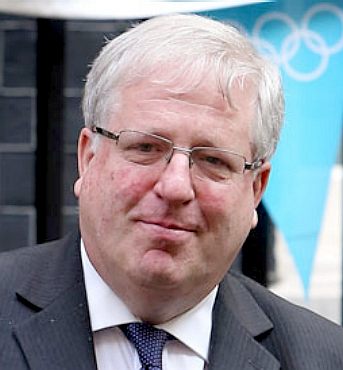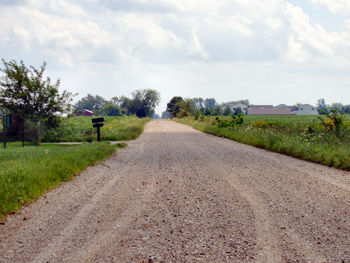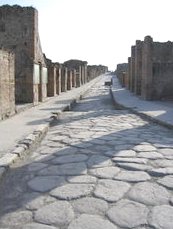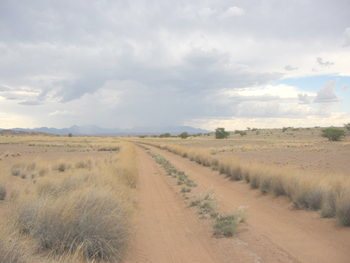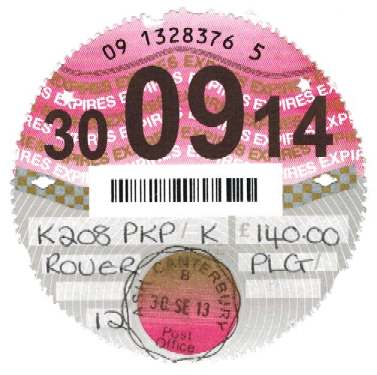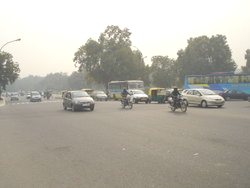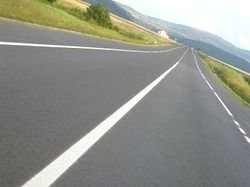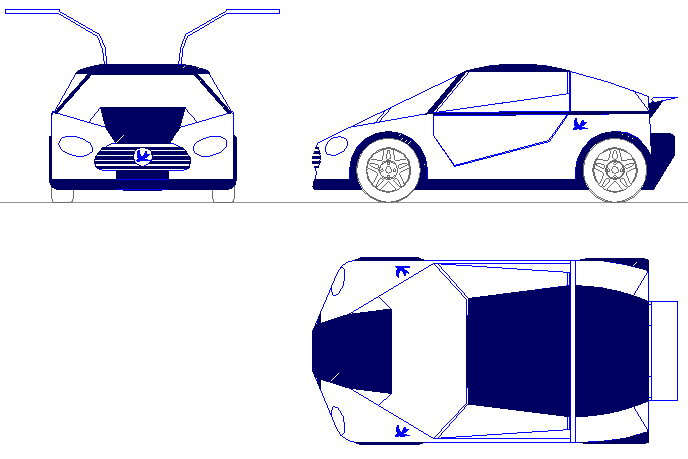|
ROADS and TRACKS
|
|
|
Patrick Allen McLoughlin (born 30 November 1957) is a British politician and Member of Parliament (MP) since 1986, initially for West Derbyshire and since 2010 for its successor, the Derbyshire Dales constituency. On 4 September 2012 he was appointed Secretary of State for Transport. A former miner, he is one of the few Conservative MPs to have been a manual worker before entering
Parliament.
A road is a strip of land, smoothed, paved, or otherwise prepared to allow easy travel, connecting two or more destinations. Some roads are streets, chiefly in urban areas.
In the context of railways (railroads in American English), a road is a single track, which may be part of a multi-track system or may be an isolated line. In the context of sea transport, a road is an anchorage.
Typical country road Indiana
Usage and etymology
In original usage, a "road" was simply any pathway fit for riding ("road" is cognate with "ride", e.g.: ships ride at anchor in roads). The word “street,” whose origin is the Latin strata, was kept for paved pathways that had been prepared to ease travel in some way. Thus, many "Roman Roads" have the word "street" as part of their street name.
However, modern usage does not usually make this distinction and it is only important since place names often hold the earlier usage in them; these days, roads are also prepared in some way. This includes, at the least, the removal of trees and smoothing of the ground. In some dialects, lower grade roads are called trails and tracks and it is uncertain where "road" begins and trail ends. Roads are a prerequisite for road transport of goods on wheeled vehicles.
The word “road” emphasizes its function of transportation along its length, while a “street” may be considered to have activity and commerce taking place on it.
A cobblestone Roman road in Pompeii HISTORY
The first pathways were the trails made by migrating animals. By about 10,000 BC, these rough pathways were used by human hunter nomads following these herds.
Street paving has been found from the first human settlements around 4,000 BC.
The oldest engineered road discovered is the Sweet Track causeway in England, dating from the 3800 BC.
The Ancient Egyptians constructed a stone paved road to help move materials for the building of the Great Pyramid in about 3000 BC.
The ancient Chinese constructed an extensive system of roads, some paved, from about 1100 BC onwards. By 20 AD, the Chinese road network extended over 40,000km.
The Incas built fine highways for couriers through the Andes, and the Mayans built an extensive network of paved roads in Mexico before the European discovery of the New World.
In ancient times, transport by river was far easier and faster than travel by road, especially considering the cost of road construction and the difference in carrying capacity between carts and river barges. A hybrid of road transport and ship transport is the horse-drawn boat in which the horse follows a cleared path along the river bank.
From about 300 BC, the Roman Empire built straight strong stone Roman roads throughout Europe and North Africa, in support of its military campaigns.
Sand track
Road construction and maintenance in Britain was traditionally done on a local parish basis. The poor and variable state of the roads that resulted lead to the first of the 'Turnpike Trusts' around 1706. These were formed to build good roads and collect tolls from passing vehicles. Eventually there were approximately 1,100 Trusts in Britain and some 38,000 km of engineered roads.
Engineered roads in the age of horse drawn transport aimed for a maximum gradient of 1 in 30 on a macadamized surface since this was the steepest a horse could exert to pull a load up hill which it could manage easily on the flat. Notable road engineers from this period are Pierre Marie Jérôme Trésaguet (1716-1796) in France and John Loudon McAdam (1756-1836) in England.
Thomas Telford - Colossus of Roads UK
Thomas Telford (August 9, 1757 - September 2, 1834) was born in Westerkirk, Scotland. He was a stonemason, architect and civil engineer and a noted road, bridge and canal builder.
During his later years, Telford was responsible for rebuilding sections of the London to Holyhead road (a task completed by his assistant of ten years, John MacNeill; today, the route is the A5 trunk road). Between London and Shrewsbury, most of the work amounted to improvements (including the Archway cutting in north London and improvements at Barnet and South Mimms). Beyond Shrewsbury, and especially beyond Llangollen, the work often involved building a highway from scratch.
Notable features of this section of the route include the iron bridge across the River Conwy at Betws-y-Coed, the ascent from there to Capel Curig and then the descent from the pass of Nant Ffrancon towards Bangor.
On the island of Anglesey a new embankment across the Stanley Sands to Holyhead was constructed, but the crossing of the Menai Strait was the most formidable challenge, finally overcome by the Menai Suspension Bridge (1819-1826). Telford also worked on the north Wales coast road between Chester and Bangor, including another major suspension bridge at Conwy, opened later the same year as its counterpart at Menai Bridge.
During the industrial revolution,the railway developed as a solution to the problem of rutting of the road surface by heavy carts. Instead of trying to build a strong surface across the whole road the cart was constrained to run either on rails or grooves which could be made of much stronger, wear resistant material.
Today, roads are almost exclusively built to enable travel by car and other wheeled vehicles. In most countries, road transport is the most utilized way to move goods. Also, in most developed countries, roads are formally divided into lanes to ensure the safe and smooth movement of traffic.
This is what it is all about, a circular paper disc that we used to put in our windscreens for fear of prosecution. We stayed silent about the unfairness of the charges for fear of being burned at the stake. But times change and now we can speak our minds as a right to be heard.
Funding
Road building and maintenance is an area of economic activity (compare military spending) that remains dominated by the public sector (though often through private contractors). Roads (except those on private property not accessible to the general public) are typically paid for by taxes (often raised through levies on fuel), though some public roads, especially highways are funded by tolls.
One way road in New Delhi, India, driving on the left side of the road
Driving on the right or the left
Traffic drives on the right or on the left side of the road depending on the country. See Left or right side of the road. In countries where traffic drives on the right, traffic signs are mostly on the right side of the road, roundabouts (traffic circles) go counter-clockwise, and pedestrians crossing a two-way road should watch out for traffic from the left first. In countries where traffic drives on the left, the reverse is true.
Traffic flow and road design in both cases are each other's mirror image.
Design
Road design consists of two important technical aspects: Besides these two technical sides of the design, environmental issues, planning issues and juridical issues are important.
Major road near Sibiu, Romania
CONSTRUCTION
Road construction requires the creation of a continuous right-of-way, overcoming geographic obstacles and having grades low enough to permit vehicle or foot travel. Removal of earth and rock by digging or blasting, construction of bridges and tunnels, and removal of vegetation (this may involve deforestation) are often needed. A variety of road building equipment is employed in road building.
The soil is tested to see if it will support weight and if not, a layer of soil is removed and replaced. The soil is compacted to form what is known as a "base course". On top of the base course is placed a wearing course which consists of asphalt concrete or concrete. While the main purpose of the wearing course is to prevent moisture from entering the road, for safety reasons this wearing course must also be constructed to ensure adequate grip (and skid resistance) with vehicles.
Modern roads, and indeed many ancient ones, such as those built by the Romans, feature a convex lateral surface known as camber. This is designed to allow water to drain away from the road to its edges. Water is then carried away by gutters to drains placed at intervals. Some roads don't have gutters and water simply drains away to a naturally porous verge, or into ditches. Modern roads that carry motor traffic also employ camber in curves to aid traffic stability by allowing them to "bank into" the bend to some extent.
On the side of the road there may be retroreflectors on pegs, rocks or crash barriers, white toward the direction of the traffic on that side of the road, and red toward the other direction. In the road surface there may be cat's eyes: retroreflectors that protrude slightly, but which can be driven over without damage.
Road signs are often also made retroreflective or even illuminated in rare circumstances. For greater visibility of road signs at daytime, sometimes fluorescence is applied to get very bright colors.
Like all outdoor structures, roads deteriorate over time. They may develop cracks or potholes, or be washed away altogether by floods. Cracks can be filled with various sealants and potholes can be filled with fresh asphalt, but eventually a whole new surface is needed. Lack of maintenance speeds up the deterioration, especially in frost-prone areas, as water enters the cracks, and freezes under the road. The resulting ice has a bigger volume than the water, which causing a localized rising and falling (when the ice melts again) of the wearing course which can severely damage the road.
Most European countries have strict standards for road construction that ensure that most roads should be able to go 30 years or longer between major resurfacings. The United States and many other countries have less stringent standards under which most roads last only 20 to 25 years. However, even those countries with stricter standards suffer from increasing levels of truck traffic, which is mainly responsible for road damage (see below).
On any road, the load per vehicle axle passing over it is mainly responsible for the amount of wear. According to a series of experiments carried out in the late 1950s, called the AASHO Road Test, it was empirically determined that the effective wear done to the road is roughly proportional to the 4th power of vehicle weight. As a result, truck traffic almost always is the exclusive 'real' cause of road damage.
In an example, a hypothetical car weighs half a ton per axle. A 6-axle, 38-ton truck also travelling on the same road weighs in at over 6 tons per axle. The truck causes 20,736 times the wear of the car (12 times the car's axle load, with a power of 4, yielding 12^4 = 20,736). Actual trucks can have even higher axle loads, though there is a wide variation in the configuration of trucks, with some having larger, wider tyres, or multiple tyres per axle, which will cause the exact figures to vary. While such figures sound dramatic, it should be realised that a single car causes almost no wear at all, so 20,000 times this figure still may not be very high. The wear is only measurable over an extended period.
The legendary Route 66, USA
LINKS
Sorn-statutory-off-road-notification UK Government DVLA driver and vehicle licensing agency Money Matters to me TAX Road Fund Licence The AA motoring_advice car buyers guide to road tax UK Government vehicle registration certificate V5C log book UK government Patrick Mcloughlin https://www.gov.uk/government/people/patrick-mcloughlin http://en.wikipedia.org/wiki/Patrick_McLoughlin https://www.gov.uk/government/ministers/secretary-of-state-for-transport https://www.gov.uk/vehicle-registration-certificate-v5c-log-book http://en.wikipedia.org/wiki/Vehicle_excise_duty http://en.wikipedia.org/wiki/Road_Fund https://www.gov.uk/sorn-statutory-off-road-notification https://www.gov.uk/make-a-sorn https://www.gov.uk/government/organisations/driver-and-vehicle-licensing-agency http://www.moneymatterstome.co.uk/3-Where-money-goes/Sub1/TAX-RoadFundLicence.htm http://www.parkers.co.uk/cars/advice/road-tax-guide/ http://www.theaa.com/motoring_advice/car-buyers-guide/cbg_roadtax.html
The blue bird legend continues: Team Speedace plan to run the Ecostar DC50 above from John O'Groats in Scotland to Lands End in Cornwall in an attempt to beat the current record set in a Tesla in 2013. This is a zero emission vehicle that is very affordable - and with solar panels fitted for assistance, may cost nothing to run for those who do not do many motoring miles a week.
The Bluebird World Cup Trophy challenge
|
|
|
This
website is copyright © 1991- 2018 Max Energy
Ltd. All rights
reserved. The bird logo
|
